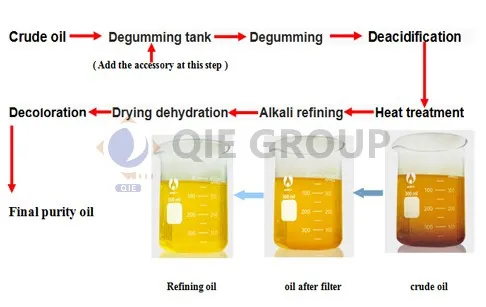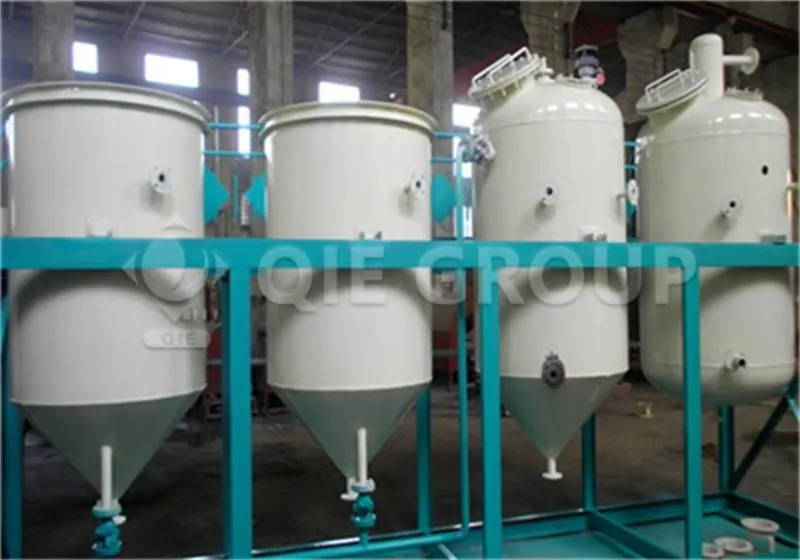

In the edible crude oil refining process, edible crude oil refining equipment plays a vital role. Its working process first pumps the crude oil into the refining pot, and then performs degumming, neutralization and other operations. When the oil soap is observed to be obviously separated and sinks rapidly, stop stirring and let it stand for a while. After that, the upper clear oil is sucked out by the equipment and transferred to the water washing tank. At the same time, the soap stock is discharged into the soap stock barrel through the oil drain pipe at the bottom. If the soap stock is found to have a high oil content, stop draining the oil immediately and pump the soap stock into the soap stock tank through a pump. The remaining oil in the refining tank is mixed and then enters the next tank for further processing. The clear oil transferred from the refining tank is washed with water and then enters the decolorization tank for adsorption and decolorization.
Removal of insoluble impurities: Edible crude oil refining equipment uses physical means such as sedimentation, filtration, centrifugal separation, etc. to effectively remove insoluble impurities such as sand and cake residue in the crude oil, laying a good foundation for subsequent refining steps.
Degumming process : The degumming process is to remove impurities such as phospholipids, mucus, resin, protein, sugar and trace metals in crude oil. Common degumming methods include hydration degumming, acid refining degumming or enzyme degumming. Each method has its own characteristics and can be selected according to the specific situation of crude oil.
Alkali refining and deacidification : Alkali refining and deacidification is carried out by neutralization with caustic soda or alkaline solution. This process can effectively remove free fatty acids (FFA), acidic pigments, sulfides, oil-insoluble impurities and trace metals in the oil, significantly improving the quality of the oil.
Decolorization process : The edible crude oil refining equipment uses activated clay, aluminum silicate, activated carbon and other adsorbents in the decolorization process, which can effectively remove various pigments, colloids, oxides, etc. in the oil, making the color of the oil clearer.
Deodorization or physical refining : Deodorization or physical refining using the vacuum stripping principle can remove low-molecular odorous substances in the oil and further improve the sensory quality of the oil.
Dewaxing or defatting : mainly uses freezing, crystallization or winterization crystallization, fractionation and other methods to remove wax or solid fat in the oil to meet the needs of different oil products.
Filtration and fine filtration : Use appropriate filtration equipment to remove solid particles in crude oil, bleached oil and catalysts in hydrogenated oil to ensure the clarity and quality of finished oil.

Negative pressure temporary storage design: The gel oil temporary storage tank adopts a negative pressure design. This innovative design effectively avoids the contact between oil and air, making the quality of intermediate products and final products more stable and extending the shelf life of the oil.
Vacuum decolorization and mixing: During the decolorization process, clay and oil are mixed in a vacuum state, avoiding air interference, improving the utilization rate of clay, and achieving a better decolorization effect. Under the premise of achieving the same decolorization effect, the consumption of clay is smaller, reducing production costs.
Automatic filtration control: The filter adopts an automatic control system, which simplifies the operation process, makes the production process more stable, and improves production efficiency.
Accurate clay metering: The equipment can accurately and automatically meter the proportion of added clay according to the actual needs of decolorization to ensure the stability and consistency of the decolorization effect.
Closed filtration environment: The filtration of decolorized oil is carried out in a closed stainless steel filter disc filter, with low residual oil content in the filter cake, simple operation, low equipment failure rate, and reduced maintenance costs.
Uniform mixing and contact: Continuous and good mixing process ensures that all particles of the clay are in uniform contact with the oil product, giving full play to the adsorption effect of the clay and further improving the decolorization effect.

QIE GROUP is a professional edible oil refinery design and manufacturing company. So far, we have helped customers in more than 60 countries build edible oil refineries with different capacities, such as Egypt, Bangladesh, Indonesia, Nigeria, South Africa, Kenya, Tanzania, India, Philippines, Thailand, Zambia, Russia, Serbia, Congo, Togo, Kazakhstan, etc. Our engineers can design and provide the most suitable edible oil refinery solutions according to your actual production needs. Welcome to contact us.







